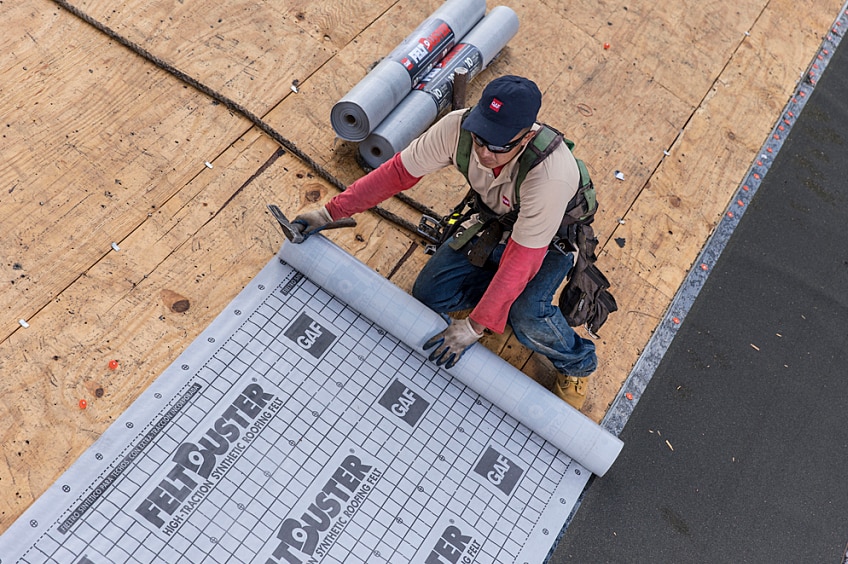La mayoría de los propietarios de viviendas no piensa en todas las partes que componen el techo de su casa, pero hay muchos elementos debajo de tus tejas.
Las tejas son la capa exterior del techo y ayudan a protegerte de los rayos del sol, la lluvia, la nieve y el viento. Debajo de ellas, hay otra capa de protección entre la cubierta del techo y las tejas: la capa base, que es fundamental para proteger tu hogar del daño causado por la humedad.
What Is Roof Underlayment, and Why Is It Important?
This layer of your roof system is typically made of asphalt saturated felt or modern synthetic materials. It covers your entire roof deck, acting as a secondary moisture barrier between the roof deck and the overlying shingles (or other roof covering) to help prevent wind-driven rain from infiltrating your home through the roof.
In other words, it helps keep your home dry. It's just one of many layers of materials that make up your roofing system, and all of them have to be installed properly for your roof to provide the best protection against the elements.
What Are the Different Types of Roof Underlayment?
Roof underlayment is usually made of either asphalt-saturated felt or synthetic materials. In either case, it provides a secondary water-shedding layer of protection that helps keep water during a rain event from infiltrating your home. GAF offers several types of roofing underlayment for different types of homes and price points.
Deck-Armor™
Combining strength with it's premium breathable technology, Deck-Armor™ Premium Roof Deck Protection helps protect your home from wind-driven rain and trapped moisture. Trapped moisture can lead to the growth of mold, mildew, or rot, which can result in damage to your roof system. This lightweight, slip-resistant roofing underlayment is easy for workers to install, even on steeply pitched roofs. It's breathable technology makes it an excellent choice for premium roof systems.
Tiger Paw™
Tiger Paw™ Roof Deck Protection is a premium, UV-stabilized synthetic roof underlayment with a moisture-control design that helps to reduce moisture on the roof deck and provide a strong layer of protection against wind-driven rain that can damage your roof structure or home interior. Recommended for asphalt shingles, slate, wood, metal, or mechanically-attached tile roofs, this layer combines strength and resilience, so it won't rot or get brittle. It also resists buckling to give your roof a smooth appearance and is specially designed to provide excellent walkability for roofers.
FeltBuster®
The value-priced FeltBuster® Synthetic Roofing Felt is a polypropylene underlayment. Its durable construction helps it resist tearing and it won't absorb moisture that can lead to disintegration over time. It lies flatter than typical felt for a sleek looking roof.
Shingle-Mate®
For another fiberglass-reinforced roofing felt option, Shingle-Mate® Fiberglass-Reinforced Roof Deck Protection acts as a secondary layer of protection against wind-driven rain. Conventional asphalt felts can bubble or wrinkle when they come in contact with moisture, which can detract from the look of your finished roof. Shingle-Mate's fiberglass reinforcement helps it lay flat and reduces wrinkling for a great finished look.
VersaShield®
VersaShield® Fire-Resistant Roof Deck Protection helps many roofing systems achieve a high UL fire rating* while providing a secondary layer of protection against wind-driven rain. The fiberglass reinforcement helps keep it flat for a great finished look.
GAF roof deck protection qualifies for a Lifetime limited warranty when installed with additional qualifying products**. Find a contractor certified by GAF*** in your area to discover the various products that are available for your home.
*Please refer to Underwriters Laboratories Certifications Directory for actual assemblies.
** Lifetime refers to the length of warranty coverage provided and means as long as the original individual owner(s) of a single-family detached residence [or eligible second owner(s)] owns the property where the qualifying GAF products are installed. Para los demás dueños/estructuras, la cobertura de por vida no corresponde. La cobertura de por vida en tejas requiere el uso de tejas de por vida de GAF únicamente. La cobertura de por vida en tejas y accesorios requiere el uso de cualquier teja de por vida de GAF y de al menos 3 accesorios de GAF elegibles. Consulta la garantía limitada de GAF para el sistema de techo para ver todos los detalles de la cobertura y las restricciones. Visita gaf.com/LRS para ver los productos elegibles de GAF. Para ver las instalaciones no elegibles para la garantía limitada de GAF para el sistema de techo, consulta la sección Garantía limitada para tejas y accesorios de GAF.
***Los contratistas inscritos en los programas de certificación de GAF no son empleados ni agentes de GAF, y GAF no controla ni supervisa de otro modo estas empresas independientes. Los contratistas pueden recibir beneficios, como puntos y descuentos de recompensa por lealtad en herramientas de comercialización de GAF por participar en el programa y ofrecer a GAF garantías mejoradas, que requieren el uso de una cantidad mínima de productos de GAF.




